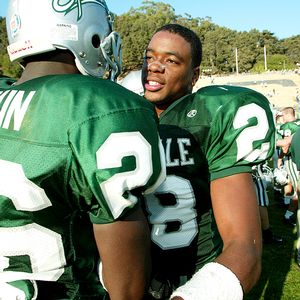 The late 1980s and early 1990s were a golden age for stories about poor urban blacks. Besides great movies such as Boyz N the Hood and Hoop Dreams, there were great articles in major publications: Nicholas Lemann's series on the black migration in The Atlantic Monthly (here is one early story); Darcy Frey's profile of a high school basketball team for Harper's; and Leon Dash's profile of an elderly black woman and her family for The Washington Post.
Now come two new fresh stories: George Dohrmann's story about black teenage athletes in California's East Bay and Hanna Rosin's story about rising crime rates in Memphis. Both are similar to their predecessors in many ways -- thorough and detailed reporting, the use of novelistic techniques, and a general air of hopelessness and even despair. Although the two new stories are fresh and original, they also share a weakness of their older counterparts.
The late 1980s and early 1990s were a golden age for stories about poor urban blacks. Besides great movies such as Boyz N the Hood and Hoop Dreams, there were great articles in major publications: Nicholas Lemann's series on the black migration in The Atlantic Monthly (here is one early story); Darcy Frey's profile of a high school basketball team for Harper's; and Leon Dash's profile of an elderly black woman and her family for The Washington Post.
Now come two new fresh stories: George Dohrmann's story about black teenage athletes in California's East Bay and Hanna Rosin's story about rising crime rates in Memphis. Both are similar to their predecessors in many ways -- thorough and detailed reporting, the use of novelistic techniques, and a general air of hopelessness and even despair. Although the two new stories are fresh and original, they also share a weakness of their older counterparts.
In Sports Illustrated, Dohrmann diagnoses the problem of the East Bay's culture of violence this way:
[I]n the past few years, those who work with young boys in Richmond and Oakland have noticed a decline in kids' commitment to sports. And the youngsters who do play speak grimly of their chances of emerging from their darkened surroundings. It is as if each generation believes less and less in the saving power of Little League or youth basketball or Pop Warner football. "It used to be that if you played sports, everyone protected you," says Fredrick Pugh, the president of the East Bay Warriors Pop Warner football program, which includes 295 boys ages five to 15. "Now it is open season on everybody. The neighborhoods are that devastated."
Even more haunting: A number of well-intentioned athletes, those who did everything they could to stay away from trouble, have been killed or severely wounded in street violence in recent years. No one can say exactly how many of those murdered in and around Oakland played sports, but it is undeniable that many of the most promising youngsters--serious athletic aspirants--have died. More than one youth coach laments that he attends more funerals than games these days.
In The Atlantic, Rosin casts the problem in broader relief. While conceding that crime rates in New York and Los Angeles has plummeted, she documents a disturbing counter-trend:
Lately, though, a new and unexpected pattern has emerged, taking criminologists by surprise. While crime rates in large cities stayed flat, homicide rates in many midsize cities (with populations of between 500,000 and 1 million) began increasing, sometimes by as much as 20percent a year. In 2006, the Police Executive Research Forum, a national police group surveying cities from coast to coast, concluded in a report called "A Gathering Storm" that this might represent "the front end ... of an epidemic of violence not seen for years." The leaders of the group, which is made up of police chiefs and sheriffs, theorized about what might be spurring the latest crime wave: the spread of gangs, the masses of offenders coming out of prison, methamphetamines. But mostly they puzzled over the bleak new landscape. According to FBI data, America's most dangerous spots are now places where Martin Scorsese would never think of staging a shoot-out--Florence, South Carolina; Charlotte-Mecklenburg, North Carolina; Kansas City, Missouri; Reading, Pennsylvania; Orlando, Florida; Memphis, Tennessee.
In the early 1990s, reporters cast an unsparing eye at institutions and governmental programs -- the NCAA, prisons and rehabilitation programs, welfare and high-rise housing projects. Today Dohrmann and Rosin exposed the failure of public and private programs.
 In SI, Dohrmann focused on the life of Alfred Lewis, a former football star who was shot repeatedly after venturing one night into the wrong neighborhood. Lewis's downfall began when he joined a gang. As Dohrmann shows, no other programs could help him ultimately:
In SI, Dohrmann focused on the life of Alfred Lewis, a former football star who was shot repeatedly after venturing one night into the wrong neighborhood. Lewis's downfall began when he joined a gang. As Dohrmann shows, no other programs could help him ultimately:
[Local Pop Warner president Frederick] Pugh was ready to give up on Fred but relatives persuaded him not to, and Fred was sent to Sierra Ridge Academy, an ROP facility near San Andreas, in the Sierra Nevada foothills.
Athletics are a big part of ROP's curriculum. In addition to regular academic classes and once-a-week meetings with a case manager/counselor, Fred played on the ROP baseball team and traveled with a group of kids to Colorado to compete in a triathlonlike event among all ROP schools. Fred felt safe and directed at ROP, and it was amazing how quickly sports worked its magic. He pleaded with ROP administrators to release him early so he could be back at Berkeley High for football season. "You should see me play football. That is my sport," he told other ROP students.
Private non-profit organizations have not helped Lewis' contemporaries, either:
After Jaee's murder, which remains unsolved, relatives and friends founded S.A.V.O.Y (Stop All Violence on Youth), which promotes awareness of violence against kids. The Terrance TK Kelly Youth Foundation, which his father runs, sponsors education programs for kids in Richmond and neighboring towns. Before that came the Khadafy Foundation for Non-Violence, formed by the mother of Khadafy Washington , a football player at McClymonds High in Oakland , who was shot and killed in 2000. That nonprofit helps families handle the aftermath of an untimely death, such as burial costs and grief counseling.
Young athletes die, foundations are formed, but nothing changes.
"We know we can't stop the murders," says Marilyn Washington Harris, Khadafy's mother. "But we still have to try to help."
So pervasive is the culture of violence that schools alone don't guarantee that a poor black kid will make it out. As Dohrmann shows in a related story, the late Terrance Kelly graduated from De La Salle, my alma mater with arguably the best sports program in the nation. But Kelly's status, as well as the fact that he defeated young Darren Pratcher in a basketball game, caused Pratcher to murder Kelly:
Kids from the neighborhood goaded Terrance regularly, provoking him into fights. They would accuse him of thinking he was better than they were because of the Catholic elementary school where his grandmother had enrolled him. When he was accepted to De La Salle High in Concord, and played for its heralded football program, the challenges intensified. "You think you are all that because you go to De La Salle," kids would say, to which he would answer, "No, you think I am all that because I go to De La Salle."
Similarly, Rosin details the shortcomings of the two main governmental efforts to diffuse ghetto poverty -- expand Section 8-housing vouchers and tear down high-rise public housing. This "disperse-the-ghetto approach" didn't reduce crime or lead its participants to happier lives. Instead, crime moved to new neighborhoods and residents were left feeling isolated:
In the most literal sense, the national effort to diffuse poverty has succeeded. Since 1990, the number of Americans living in neighborhoods of concentrated poverty--meaning that at least 40 percent of households are below the federal poverty level--has declined by 24percent. But this doesn't tell the whole story. Recently, the housing expert George Galster, of Wayne State University, analyzed the shifts in urban poverty and published his results in a paper called "A Cautionary Tale." While fewer Americans live in high-poverty neighborhoods, increasing numbers now live in places with "moderate" poverty rates, meaning rates of 20 to 40 percent. This pattern is not necessarily better, either for poor people trying to break away from bad neighborhoods or for cities, Galster explains. His paper compares two scenarios: a city split into high-poverty and low-poverty areas, and a city dominated by median-poverty ones. The latter arrangement is likely to produce more bad neighborhoods and more total crime, he concludes, based on a computer model of how social dysfunction spreads.
Studies show that recipients of Section 8 vouchers have tended to choose moderately poor neighborhoods that were already on the decline, not low-poverty neighborhoods. One recent study publicized by HUD warned that policy makers should lower their expectations, because voucher recipients seemed not to be spreading out, as they had hoped, but clustering together. Galster theorizes that every neighborhood has its tipping point--a threshold well below a 40 percent poverty rate--beyond which crime explodes and other severe social problems set in. Pushing a greater number of neighborhoods past that tipping point is likely to produce more total crime. In 2003, the Brookings Institution published a list of the 15 cities where the number of high-poverty neighborhoods had declined the most. In recent years, most of those cities have also shown up as among the most violent in the U.S., according to FBI data.
In a new twist in this genre, Dhormann shows the hollowness of self-help ideologies. The kicker in his main story is devastating:
Fred then slowly stood up and walked gingerly toward his bedroom. He had hung a sheet of crinkled white paper on his bedroom door, on which was printed the Pledge of Success. Seeming to notice it for the first time, he read the first three lines out loud:
Today is a new day, a new beginning.
It has been given to me as a gift.
I can either use it or throw it away.
He stopped abruptly. He saw no point in going on.
A reader must respect the unblinkered, thorough, and engaging narratives in these stories. But what none of them tackled were two key institutions in people's lives: the two-parent family and church. Only Lemann's stories touched on the importance of family structure and religion. By contrast, Rosin and Dhormann don't mention the topics at all.
Dhormann's story only tantalizes readers about the importance of rules:
If parents continue to violate a team policy, their kids are suspended for a week, same as if the players had broken a rule. "Kids want discipline, structure, and their parents or grandparents want help, so you'd be surprised how they follow the rules," Pugh says. "They won't [adhere] to a restraining order from the police, but they follow our rules because playing means so much to their kids."
This passage raises lots of questions. Are there pastors, such as the one tmatt mentioned the other day, that tell kids to abandon the hedonism of the streets and give their lives to Christ? Do scholars believe that no-fault divorce laws have encouraged men to abandon their families?
Needless to say, reporters should not limit themselves to the roles of family and religion. Declining wages for unskilled men is also part of the problem. But examining these twin institutions in full would break new and welcome ground.
(Picture at right of Darren Pratcher; at left Terrance Kelly)
